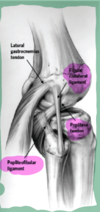Knee Lectures 3 & 4 Flashcards
(79 cards)
Ligamentous Anatomy of the Knee
What is involved here???
- ACL
- PCL
- Posteromedial Corner PMC
- MCL-Medial Collateral Lig.–superf. and deep
- Posterior Oblique Ligament
- Posterolateral Corner PLC
- Lateral (Fibular) Collateral Lig.– LCL
- Popliteal Tendon
- Popliteofibular ligament
- Acruate Ligament

Posteromedial Corner of Knee
see pics

Posterolateral Corner of Knee
see pics

Ligament Function
Rotation–NWB (*Fixed Femur)
Medial vs. Lateral Tibial Rotation
-
Medial Tibial Rotation
- ACL-2ndary
- PCL-2ndary
-
Lateral Tibial Rotation
- PLC-Primary
- MCL-Primary
- PCL- Primary in 90deg FLEX
- LCL-2ndary
Ligament Function
Sagittal and Frontal Planes
-
Anterior Translation
- ACL- Primary
- Meniscus, Capsule, Collaterals
-
Posterior Translation
- PCL-Primary
-
Varus
- LCL-Primary
- Cruciates
-
Valgus
- MCL-Primary
- Cruciates
Anterior Cruciate Ligament
ACL
what is it?
-
Primary Stabilizer
- ANT Tibial translation
- POST Femoral translation

ACL in Extension
does what?
PL Bundle taut
restricts motion
ACL in Flexion
does what ?
AM Bundle taut
restricts motion
*Anterior Drawer Test here**
ACL @ ~20-30o Flex.
does what ?
BOTH ACL & PCL contribute equally to LIMIT Ant. Tib. Translation
*Lachman Test here**
The ACL is a Secondary Stabilizer for: 4 things
- HyperEXTENSION
- Varus + Valgus forces
- Medial Tibial rotation
- Lateral Femoral rotation
ACL
Has ANT. attachment w/ _____________
has ANT. attachment w/ ANT. horn of MED. meniscus
Saving the ________ drastically reduces risk of OA
Meniscus
ACL Tears
Some stats….
- 200,000 tears/year in US
- 100,000 reconstructions
- 0-13% pts w/ isolated ACL inj. dev. OA w/ 10-15yrs
-
drastic INC in OA rates w/ meniscectomy
- __bc changing of articulation
-
drastic INC in OA rates w/ meniscectomy
- 41-50% pts who receive ACL reconstruction sx still dev. OA by 14yrs Post-OP
- inj’d knee 4x MORE LIKELY to dev. OA vs. contralat. 10yrs latera
- Approx. 80% all ACL tears are from NON-contact inj’s
***NOTE: do NOT need reconstruction Sx to avoid OA
***NOTE: ACL inj. does NOT mean you will get OA!!
NON-Contact ACL Mech’s of Injury (MOI)
- Cutting combined w/ Deceleration
- Landing from jum in or near full EXT.
-
Pivoting w/ knee near full EXT.
- MED. rotation of tibia (LAT. rot. of femur)==ACL wraps around PCL
- LAT. rotation of tibia (MED. rotation of femur)==ACL stretched over lateral femoral condyle
- HyperEXT.
- Dynamic Valgus
STUDY: Biomechanical Measures of NMSK Control and Valgus Loading of the Knee Predict ACL Injury Risk in Female Athletes
Hewett et al., AJSM. 2005
- Female ado’s 4-6x greater chance of tearing ACL vs. males
- 205 female ado. soccer, basketball, volleyball players screened for NMSK control + Jt. loads during jump-landing tasks
- 9 ACL tears reported
*NOTE: more males WITH ACL tears
*NOTE: females have a GREATER RATE
Valgus Loading & ACL Injury
- Looking @ Abnormal Frontal and Transverse Plane Mech’s
- Knee motion AND knee loading during landing task are predictors of ACL injury.
see pics

“Dynamic Valgus”
Multi-planar motion consisting of…
*remember there is a rotational component to this as well*
*Femoral ADDuction
*Knee ABDuction
*Ankle Eversion

Abnormal Frontal & Transverse Plane Mech’s
ACL-injured athlete had 2.5x GREATER Knee ABD moment and 20% HIGHER GRF
Stance time was 16% SHORTER
****Ext. moment HIGHER on injured side
Results and Discussion
Predicting ACL injury status:
Knee ABD moments
- Knee ABD moments have Sn of 78% and Sp of 73% predicting ACL injury status
Results and Discussion
Predictors of ACL injury:
Sagittal plane knee and hip Flex.
Sag. plane knee and hip FLEX====NOT predictors of injury
Results and Discussion
ACL injury predictors:
MM co-contraction quads + hams
-
MM co-contraction of Quads+HS
- proposed to DEC dynamic valgus and guard against excess. ANT TRANSLATION
ACL Injury Assessmen
Lachman’s Test
Explain…
*NOTE: Tests POSTEROLATERAL BUNDLE better vs. Ant Drawer
- Pt. SUPINE w/ Knee flexed to 30o (IMPORTANT!!!)
- Stabilize anteroLAT. DIST. femur (stabilize w/ OUTSIDE hand
- Mobilize w/ INSIDE hand —-translate TIBIA ANT. w/ OPP HAND (INSIDE HAND)
- (+) Test= Ant. translation of tibia BEYOND femur with “mushy” OR “soft” end-feel
*NOTE: Tests POSTEROLATERAL BUNDLE better vs. Ant Drawer

ACL Injury ASSESS.
Anterior Drawer Test
Explain…
**NOTE: Tests ANTEROMEDIAL BUNDLE
* Pt SUPINE w/ knee flexed to 90o
- Tibia in neut. rot.
-
Thumbs IN jt. line
- fem. condyles ~1cm POST to AM Tibial plateau @ 90deg
- Translate tibia ANT—mildly forceful
- (+) Test= INCd ANT translation and soft end-feel
**NOTE: Tests ANTEROMEDIAL BUNDLE

Clinical Exam of the ACL
-
Sensitivity
- TRUE POSITIVE rate
- people who who are (+)–what proportion actually TEST (+)
-
Specificity
- TRUE NEG. rate
- people who are (-)–what proportion actually TEST (-)
-
PPV
- how likely it is pt. HAS disease AFTER test POSITIVE
-
NPV (depends on PREVALENCE)
- how likely it is pt. DOES NOT HAVE disease if tested NEGATIVE
-
+ LR
-
likelihood that pt w/ POSITIVE TEST DOES have problem?
- LR+ rules disease IN (over 10=better)
-
likelihood that pt w/ POSITIVE TEST DOES have problem?
-
-LR
-
likelihood my pt w/ NEG. TEST DOES NOT have prob?
- LR- (very LOW (
-
likelihood my pt w/ NEG. TEST DOES NOT have prob?





















